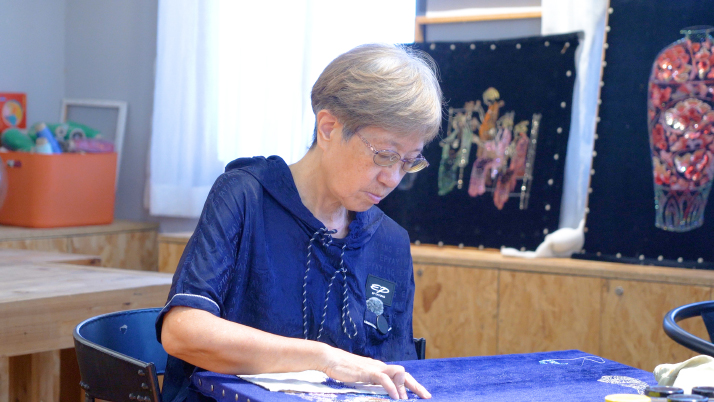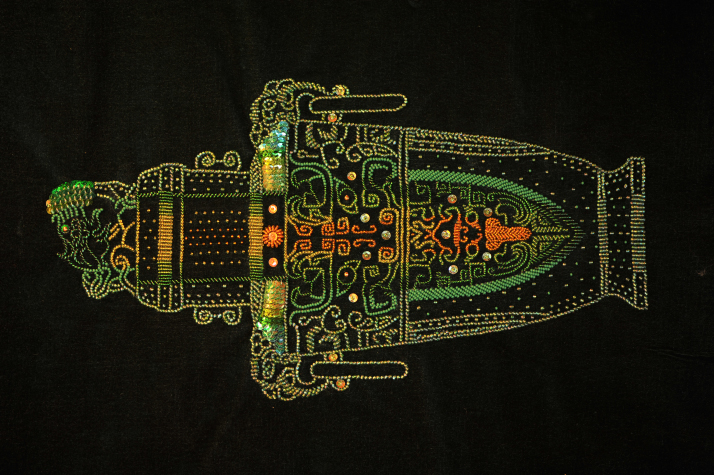| China |
| Xiamen bead embroidery inheritors integrate century-old history into contemporary culture | |
|
|
|
Located in Xiamen City, southeast China's Fujian Province, Kulangsu Island is abuzz with attractions and shops that welcome tourists from all over the world all year round. Amid all the hustle and bustle, one place offers a small oasis of calm—the island's bead embroidery studio. The studio's director Xie Liyu is a representative inheritor of Xiamen bead embroidery, a technique listed as a form of national intangible cultural heritage.
Pearl on the island Bead embroidery is a form of needlework that uses beads to create decorative designs on fabric. Since the 1970s and 80s, Xiamen bead embroidery has been a calling card of the city, but its history can be traced back over 100 years. "The existing bead embroidery objects demonstrate that the bead embroidery technique in Xiamen has been continuously practiced since the late Ming (1368―1644) or early Qing (1644-1911) Dynasty," Xie told Beijing Review. Unlike other embroidery styles in China, which all use thread to create pictures and patterns, Xiamen embroidery uses glass beads. "Glass beads have been used to decorate clothing and crafts in Europe and North America for a long time. As a trading port, Xiamen facilitated the entry and exit of missionaries from overseas as well as many Chinese. The Chinese people who worked abroad were inspired by the glass beads and their beauty, so they brought the beads back with them and tried using them on suede slippers and shoes," Xie explained.  Xie Liyu creates new bead embroidery work at her studio on Kulangsu Island in Xiamen, Fujian Province, on September 6(YIN KANG)
Sticking to one technique for decades is no easy feat, but Xie still perseveres and even delights in it, because bead embroidery has a particular charm that appeals to her. "Its unique beauty encourages us to face up to the task of passing it on. Beads and sequins interact with the given light to produce unexpected visual effects and expressive images, like a three-dimensional effect or a semi-relief state, which require some of the most intricate steps in our design process," she said. It is precisely because of this that working with the beads presents difficulties for embroiderers. "A beautiful image requires multiple and even subtle color changes. Beading is not like painting, in which colors can be fine-tuned to match any hue. A lot of times the existing beads and sequins don't convey the same effect as our original plan, so throughout the embroidery process, we are constantly testing, tweaking and coordinating the designs. Sometimes the embroidered pieces even have to be dismantled and embroidered all over again. That is, we try to create the best image we can within the limitations of the craft and with the limited materials we have," Xie added. Xie grew up on Kulangsu and the island has been a major influence on her works. She takes cultural, maritime and specific Minnan (south Fujian) elements, as well as the unique flora and fauna of the island, as inspiration for her creations. "These typical Kulangsu features are turned into bead-embroidery decorative pictures to serve as souvenirs that follow tourists home to places all over the world. In this manner, both bead embroidery and Kulangsu can achieve wider reach." In her view, Kulangsu is a World Heritage Site that embraces diverse cultures, and bead embroidery further enhances the island's identity, with the two complementing each other. From surviving to thriving Today, apart from continuing to create bead embroidery works, Xie is also dedicated to the passing on and dissemination of this craft. "This technique is saved and preserved thanks to the presence of the old masters who are proficient in it. So currently, to pass it on, the most crucial aspect is attracting and training new craftspeople. Cultivating the sixth generation of inheritors is our priority now. For them, one task is of the utmost importance: integrating bead embroidery into the current cultural industry and promote it in the market," Xie said.  A bead embroidery replica of a bronze artifact used for sacrificial imperial ceremonies during the Han Dynasty (202 B.C.-A.D. 220) (COURTESY PHOTO)
Having a background in art studies, Zhu Jin, a sixth-generation inheritor of Xiamen bead embroidery, particularly enjoyed the sense of meditation while beading, and is determined to promote this craft. Aside from teaching and lecturing about bead embroidery at colleges including the Xiamen University of Technology, Fuzhou University's Xiamen Academy of Arts and Design, as well as Jimei Industrial School and Xiamen Technical College, he also opened a bead embroidery experience store at the Kulangsu Center for Contemporary Art, an art park on Kulangsu developed by Xiamen Gulangyu Investment and Development Co. Ltd. "We aim to build a cultural and artistic park that lives up to Kulangsu's reputation as a World Heritage Site and has an international vision. An art form steeped in history and culture, Xiamen bead embroidery aligns with our park's positioning. Therefore, on the occasion of the park's opening, I immediately invited the bead embroidery team to settle in our park and open the experience store. We hope to give tourists visiting Kulangsu a distinctive experience," Lin Ru, General Manager of Xiamen Gulangsu Investment and Development Co. Ltd., told Beijing Review. In this experience store, visitors to Kulangsu can purchase bead embroidery products and also have the opportunity to try making them themselves. In addition to the basic bead embroidery products, which include decorative paintings and shoes, the store also sells accessories such as earrings, bracelets, brooches, and even fashionable clothes and haute couture." These products are all original and handmade by our bead embroidery team. The distinct difference between them and the older generation of bead embroidery products is that they are more innovative and diversified in design. Although bead embroidery is a centuries-old craft, it fits well into modern life," Zhu told Beijing Review, adding that the traditional bead embroidery products require many hours of work, therefore have high prices, and are not suitable for retail. In contrast, making small items is much simpler, and people are more inclined to purchase them. "We are currently developing along two fronts. One is to concentrate on the design and creation of large-scale works that can fully showcase the beauty of bead embroidery, to participate in national and international competitions and thereby increase recognition of the craft. The other is to make more small ornaments to promote it to a wider market," Xie said. This model also helped many housewives and laid-off women to find a new source of income. "After learning the basics with us, they can make small items at home and sell them in our studio and experience store. It's a job for them, and a supply for us. We hope that this technology can generate more positive cycles," she concluded. (Print Edition Title: Stitch by Stitch) Copyedited by G.P. Wilson Comments to kangcaiqi@cicgamericas.com |
|
||||||||||||||||||||||||||||
|